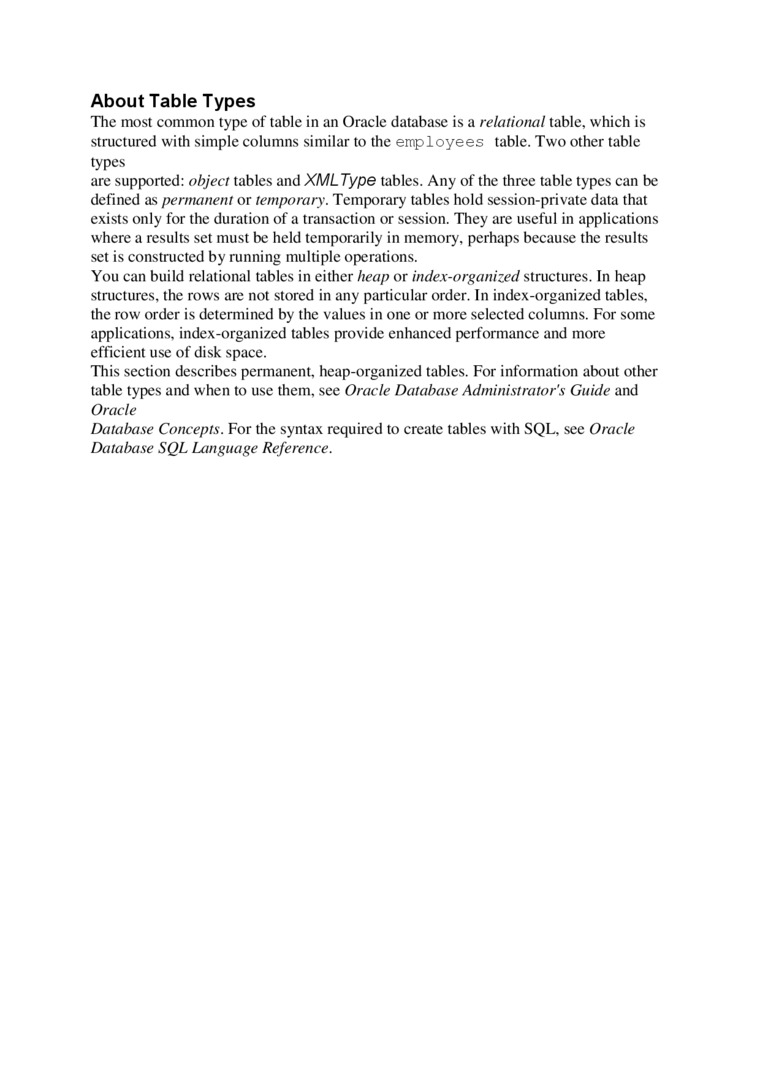79686

About Table Types
The most common typc of table in an Oracle databasc is a relational table. which is structured with simple columns similar to the employees table. Two other table types
arc supported: objęci tables and XMLType tablcs. Any of the thrcc table types can be defined as permanent or tempo tary. Tcmporary tablcs hołd scssion-private data that exists only for the duration of a transaction or session. Thcy arc useful in applications where a results set must be hcld tcmporarily in mcmory, perhaps bccausc the results set is constructcd by running multiplc operations.
You can build relational tables in either heap or index-organized structures. In heap structures, the rows are not stored in any particular order. In index-organized tables, the row order is determined by the values in one or morę selected columns. For some applications, index-organized tables provide enhanced performance and morę efficient use of disk space.
This section describes permanent, heap-organized tables. For information about other table types and when to use them, see Oracle Database Administrator's Guide and Oracle
Database Concepts. For the syntax required to crcate tables with SQL, see Oracle Database SQL Language Reference.
Wyszukiwarka
Podobne podstrony:
There are many types of disorders affecting the blood. The most common disorder of the blood is anae
some?sic preposition quiz 1 Marks: 12 You will need the most commonty used prepositbns here: in, on
About Tables The table is the basie unit of data storage in an Oracle database. It holds all user-ac
ESOPT State-of-the-art reportPenetration testing in IsraelA. Komornik The most common type of penetr
DSC09928 INFARCTS Local circulatory disturbances The most common form of cerebrovascular diseas
DSC09991 VIRAL ENCEPHAUTIS The most common cause of encephalitis Arbovirus encephalitis Herpes
clinical immuno final1 02 /8. The most common form of primary glomerulonephritis in western countrie
About Database Storage Structures An Oracle database is madę up of physical and logical structures.
UHAM066 THE CAUSES OF HEADACHE AND MIGRAINE ^ U9 Two of the most common headache-causing foods are c
Acetaminophen - poisoning o Frequency: o In the US: Acetaminophen is one of the most common pharmace
Summary Extraction of mandibular third molar is one of the most common and also the most difficult p
P5140052 Bursitis of the Elbow Theolecranon bursa is the most commonly injured bursa of the elh okcr
DSCN6628 Pneumocystosis is one of the most common infections in immunosuppressed patients with AIDS.
image001 The most ezdting fiction of our time! *13 in “The most celebrated ‘All-OriginaP senes in Sc
image002 Photo: William Rotsler TERRY CARR has been acclaimed as one of the most important editors o
więcej podobnych podstron